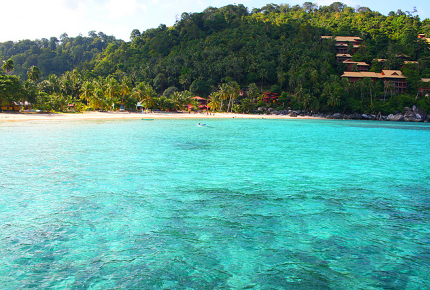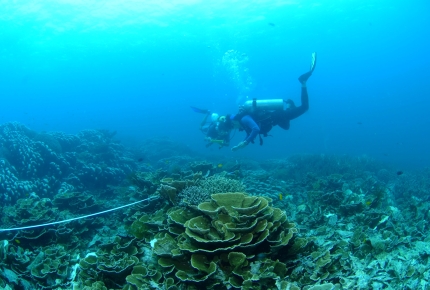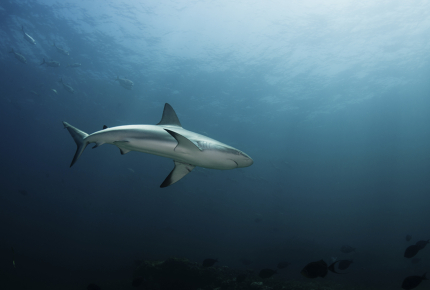Reef encounter: Can citizen science help save our oceans?
Gavin Haines explores the protected coral reefs of Tioman Island in Malaysia – all in the name of science.
There’s been a murder. A lobster the size of a small child has been slain on the seafloor. A gruesome business, it is. There are signs of a struggle, but no weapon and no apparent motive. Whodunit?
The smart money is on a shifty looking shark, circling suspiciously in the distance, though a nearby turtle could know more than he’s letting on (it’s always the quiet ones). And what about that gang of parrotfish? They must have seen something.
The ocean is full of mysteries. The deeper you go the more profound they become. In fact, we know more about the surface of the moon than the deep blue sea, but one thing we can be sure of is this: the world’s coral reefs are in a perilous state. Culprits abound. Overfishing, pollution, coral disease and climate change have all been linked with their decline, but further research is required.
And that’s why I have come to the island of Pulau Tioman in Malaysia: to help conduct said research with a non-profit organisation called Biosphere Expeditions. Biosphere turn ordinary folk like me into citizen scientists, training them to collect data that is then passed onto real scientists at an organization called Reef Check. These scientists collate the information, compile reports and use them to lobby governments and help shape environmental policy.
So how can a dunce like me, whose mind was often elsewhere when it came to matters of science at school, be expected to collect such vital information? I can’t. At least not until I have learned the ways of the ocean and passed an exam.
 Tioman Island is surrounded by a protected marine reserve
Tioman Island is surrounded by a protected marine reserve Creative Commons / Jorge Cancela
Cue Katie Yewdall, a marine biologist from England, and Paul O’Down, a bushman and Biosphere expedition leader from Australia (think Steve Irwin meets Crocodile Dundee), who have been putting me and my fellow students – Edzard and Julie from Berlin, and Rebecca from Burnley, England – through rigorous training in the classroom.
Over the last few days, in the Tioman Dive Centre, we’ve had a crash course in coral, studied fish and learned what the presence of certain species means at a reef. We have tested our newfound knowledge in the water, where we found the murdered lobster, and in an exam, which Julie and I failed. So while the other guys enjoyed one last night on dry land before the expedition got underway, we hit the books and had another go.
Out at sea
“I am pleased to tell you, that you have passed.” Katie delivers the good news on the deck of our yacht, as it bobs in the gentle swell off Pulau Tioman. A day after everybody else on the expedition, Julie and I have finally earned our stripes.
Jubilantly we jump into the crystalline ocean with our long-suffering tutor, joining the rest of the gang and our skipper, Carlton, who are snorkelling and free-diving around the vessel.
This will be our life for the next week. No more private lodgings or power showers, no more late night bars or sandy beaches. Instead we will be living aboard this beautiful yacht, sailing around Tioman and exploring her remote reefs, which sit within a protected marine zone.
“Some of these reefs may have never been dived before,” says Paul, as we weigh anchor and set off for our first dive.
 Citizen scientists survey a reef in Pulau Tioman
Citizen scientists survey a reef in Pulau TiomanReef Check
Conducting a research dive is simple: you find a reef, drop anchor nearby and don your scuba gear. Two divers then go down and lay a 100m (328ft) surveyor’s tape over a randomly selected section of reef. After 10 minutes, the other four descend: two count fish (only ones swimming 2.5m (8ft) either side and 5m (16ft) above the transect line) and record their size, while the other two record substrates (coral, sponges, etc). Finally, the pair that laid the tape sweep along to count invertebrates.
All this takes just over an hour, after which everyone ascends with exciting observations and plastic slates covered in notes (pencil works best underwater). Back on the boat, our findings are punched into a laptop over a cup of tea or a beer.
The diving is spectacular. Pristine reefs harbour an astonishing variety of fish, which glide along the coral in a kaleidoscope of colours. We see giant turtles, moray eels the size of tree trunks and skittish sharks, which disappear from sight the moment we look at them. On another dive we are joined by a friendly sea snake. “They like to swim along with you,” explains Paul, after the dive. “They use divers as protection from sea eagles.”
Sadly, it’s not all unspoiled coral and bountiful marine life. On one depressing dive we discover a reef that had been blown to smithereens by dynamite, used by lazy fishermen to illegally catch their quarry. It’s bereft of life. Millions of years and many miracles had gone into making that reef, only for it to be annihilated in milliseconds.
 Lucky divers may get to see the local reef sharks
Lucky divers may get to see the local reef sharksShaneGross / Thinkstock
More unpredictable than the diving is the weather. On one glorious morning we descend into calm waters under blue skies only to resurface in the eye of a storm. We clamber onto the swaying boat, holding onto the ladder while waves relentlessly pummel us. It’s dangerous, but utterly exhilarating.
We seek shelter from the stormy weather on Pemangil Island, where we treat ourselves to a meal out. From the restaurant we listen nervously to the rumbles of thunder, which brings joy to a film crew, who have come from Kuala Lumpur to shoot a horror movie on the island.
The real horror story, however, is what’s happening to our coral reefs. And critics would rightly question the wisdom of us flying halfway around the world to research these endangered ecosystems, whose toughest test could actually come from climate change.
It’s a valid point, but such research is essential, say scientists, to help manage Tioman’s protected marine reserve and develop conservation strategies in regions where reefs are faring less well. And for scuba divers, a trip like this is an opportunity to give something back to the oceans, rather than simply being a voyeur.
We never did solve the mystery of the murdered lobster: the perpetrator is still at large. But together with other citizen scientists around the world, perhaps we can help scientists solve more important questions that will, ultimately, help save the world’s coral reefs.
NEED TO KNOW
To participate in this expedition, you must be a qualified scuba diver. As a non-profit organisation Biosphere Expeditions require a contribution of £1,590 for this eight-day research trip, which covers all food, lodgings, training, local transport and approximately 22 dives. It excludes flights to Singapore, where the expedition meets.
The next trip to Pulau Tioman departs in August 2016, but a similar expedition will be happening in September 2015 in the Maldives. Visit www.biosphere-expeditions.org for more information.
 Reefs are worth an estimated $9.6 billion in tourism
Reefs are worth an estimated $9.6 billion in tourismTanya Puntti / Thinkstock
CORAL REEFS IN NUMBERS
• $9.6 billion is the estimated worth of coral reefs to the global tourism industry (Cesar, The Economics of Worldwide Coral Reef Degradation)
• 58% of the world’s coral reefs are threatened by human activity (World Resources Institute)
• 27% of the world’s coral reefs have already been lost (Cesar, The Economics of Worldwide Coral Reef Degradation)
• 34% of the world’s coral reefs are found in Southeast Asia (World Resources Institute)
• 50% of the Great Barrier Reef is thought to have been lost in the last three decades, prompting UNESCO to consider placing the ecosystem on its list of World Heritage Sites in Danger
Liked this? Then have a read of these:
12 ethical experiences for 2015
Does voluntourism do more harm than good
Do you have any Feedback about this page?
© 2025 Columbus Travel Media Ltd. All rights reserved. No part of this site may be reproduced without our written permission, click here for information on Columbus Content Solutions.









 You know where
You know where